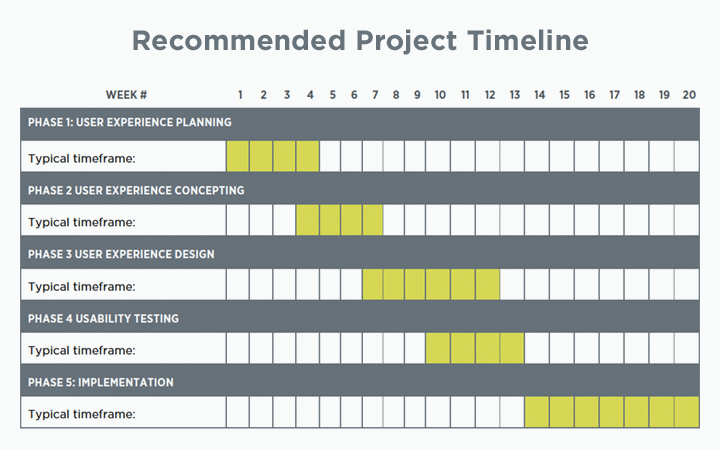Avoid the Swoop and Poop with Good Planning
The Swoop and Poop?
You’ve spent months collaborating on an interactive project with your agency or consulting team— gathering input from your users, establishing objectives, crafting the strategy, building one deliverable at a time. You’ve reached the phase in the project where you have options for the visual design of the UI. Now that there’s something visual to react to, you share the design options with a few key stakeholders to see which option they prefer. You are surprised and dismayed to learn that some key decision makers don’t pick an option but rather start commenting— “we need to add content about <x>”, “can we add video?”, “can you make it pop?” They drop bad ideas on your project without taking any of the objectives or constraints into account— the way a seagull swoops down, steals a bit of food, and poops– without taking the fact that you’re having a picnic into account. What just happened? You went in hoping for a decision between two visual options and you came out with a project that unraveled before your eyes.
You’ve fallen victim to the dreaded swoop and poop. Sadly, your project is likely going to suffer time and cost overruns as a result. Let’s take a look at why this phenomenon is so common and provide some insight into how we work with our clients to avoid it.
“When can it be live?”
It’s often the first question we hear from clients when we’re working through the details of a potential interactive project. Obviously, having an understanding of how long something is going to take is a key factor in deciding whether to move forward with the work.
In our initial proposals we provide a high-level timeline that reflects our experience working with large, hierarchical organizations. At first glance, because these timelines lack a lot of detail, they can appear protracted and lengthy. More often than not, potential clients ask if there are ways to get the project done faster.
Our answer is always the same—as a small, nimble team of experts with years of specialized experience developing complex user experiences for large companies, we can move exceptionally fast.
Timelines: The Devil is in the Details

Can you move faster? Wait, not so fast!
So, we provide an amended timeline with a simple caveat, “this timeline assumes that the client team will provide consolidated and actionable feedback within two days of the review of all deliverables.” For a myriad of reasons, delivering on this assumption is nearly impossible for most client teams. One of the most common causes for unexpected delay is the influence of non-participating power.
Wait, what is non-participating power?
Non-participating power describes decision makers who wield influence over the direction of a project in the absence of their consistent involvement and collaboration on that project. We have written in the past about how non-participating power affects collaboration and the same dynamics are at play when we look at how it affects timelines and project development.
These are typically busy people with schedules that preclude them from regularly attending meetings and engaging with the day-to-day activities that shape a project. Yet, at some level, they are responsible for or have a stake in the project’s success.
If you don’t plan for their input and engage them thoughtfully, you run the risk that they’ll swoop in unexpectedly and cause frustration.
To be clear, it is absolutely important to listen to outside voices and allow those not enmeshed in the details to have input. But ceding too much control of the fate of a deliverable to someone unfamiliar with the context, strategy, and purpose of that deliverable is a recipe for disaster.
Planning for Non-Participating Power
Non-participating power poses a significant risk to the on-time/on-budget delivery of the final product. Yet, these individuals and their roles are a function of the structure of the organizations we work with. We have to look at ways to plan for their influence and do our best to use it as a means to improve (rather than just delay) our projects.
When a project is approved, our first step is to create a detailed timeline that contains both milestones and dependencies. Once these details are included, what once seemed like a protracted schedule can appear more ambitious and challenging.
We work with our core client team to identify all of the stakeholders that will exert influence over the final product. Then, we work to incorporate review time for these individuals into the project plan. Projects run smoother when expectations have been set in advance and time has been allocated to gather and incorporate feedback from non-participating power.
Tips for Handling Non-Participating Power
In addition to planning when the reviews should occur, we work with our core client team to build a narrative and set the stage for each deliverable being reviewed by non-participating power. At all costs, avoid scenarios in which you’re attempting to gather feedback or approval by emailing the document without any context or background.
- Make every attempt to involve decision makers early and often. If they’ve bought into the strategy, they are more likely to understand the feature list. If they’ve seen the feature list, there is a better chance they’ll buy into the wireframes, etc.
- Don’t play telephone. Instead of trying to present “up-the-chain”, plan to have non-participating stakeholders attend meetings where key deliverables are being reviewed. We can anticipate concerns and respond to their questions in real time. This is far more effective than presenting to your boss in our absence and trying to advocate on behalf of work that we created.
- Make us aware of organizational, political, or personality challenges. If we’re aware of them, we can shape the narrative to speak to specific issues. It helps if we know that there is a power struggle at the executive level, if your last agency never delivered on its promises, or that a given person just likes to hear themselves talk.
In the future, we’ll explore some additional factors that cause delays and budget overruns. For now, keep these tips top of mind on your next project and avoid the dreaded swoop and poop.
Want to learn more about our services, philosophy or approach? Please contact us.
Related Insights
-
Budget constraints are real, and teams are being asked to do more with less all the time. But, failing to meet certain expectations can result in disappointed customers, regulatory or legal hassles, competitor disruption, and loss of business. -
The UX of Critical Failure
Do you have a mechanism in place to communicate to your customers and users if your site or system experiences a critical failure? If not, there’s no time like the present to identify a strategy that will inform your users of the problem and communicate key details about the outage. -

Get Started with Voice-First Experience
The explosion of smart speakers means now may be the time to start thinking beyond the screen. We'll review some background about voice-first technology and provide a few examples of how other organizations are using it.
